Delhi, the vibrant capital of India, is a city rich in history and culture. The iconic Red Fort, a UNESCO World Heritage Site, showcases Mughal architecture with its massive red sandstone walls. Nearby, Jama Masjid, one of the largest mosques in India, stands as a testament to Mughal grandeur. A short walk takes you to Chandni Chowk, a bustling market known for its street food and traditional shops, offering a glimpse of the city's heritage. The India Gate, a war memorial, honors the soldiers who died in World War I and is surrounded by lush lawns, perfect for leisurely strolls. The serene Lotus Temple, designed in the shape of a lotus flower, promotes peace and spirituality, while Akshardham is a magnificent temple complex that showcases India's ancient art and architecture. Together, these landmarks represent Delhi's rich tapestry of history, spirituality, and modernity.
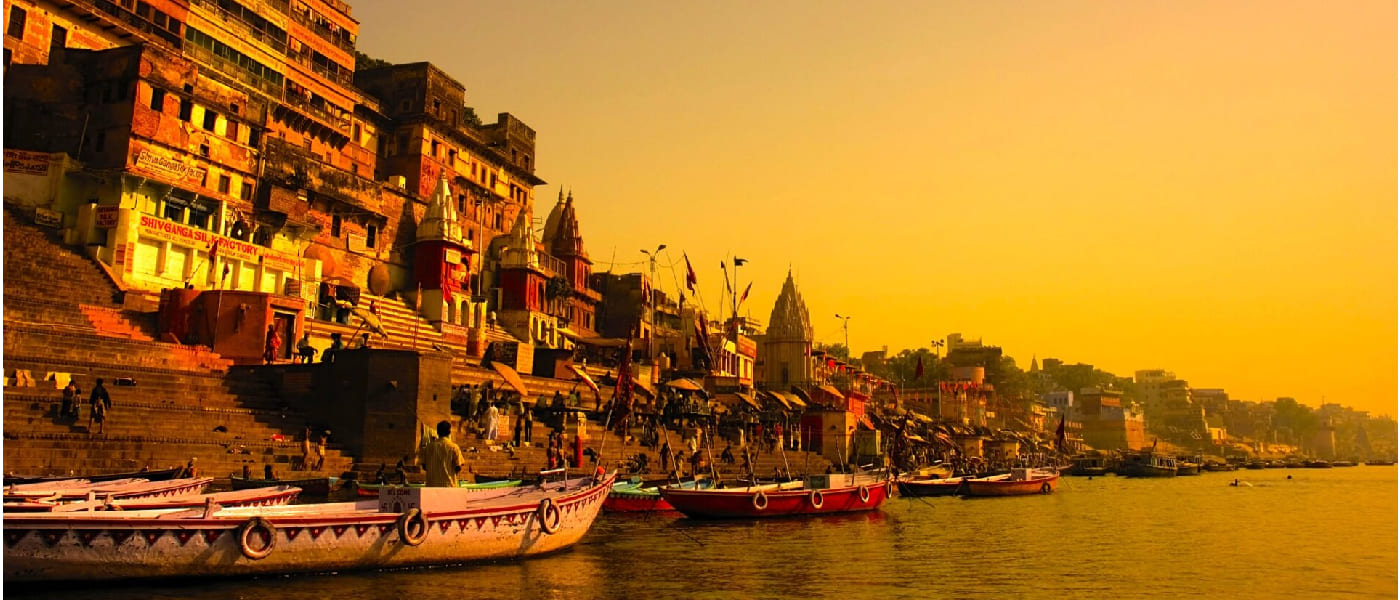
9N 10D Delhi Jaipur Agra On they Way Gwalior Orchha Khajuraho Varanasi
India Tour Package presents an exciting 9 Nights 10 Days journey, covering some of India’s most iconic destinations. Starting from Delhi, the vibrant capital, explore historical landmarks like the Red Fort, Qutub Minar, and India Gate. Next, head to Jaipur, the Pink City, where you'll witness the grandeur of Amber Fort, City Palace, and Hawa Mahal. Continue to Agra, home to the world-famous Taj Mahal, and visit Agra Fort. On the way to Orchha, stop by Gwalior to explore its majestic fort. Orchha offers a glimpse into India's royal past with its palaces and temples. Next, travel to Khajuraho, renowned for its intricate temples showcasing ancient Indian art. End the journey in the spiritual city of Varanasi, where you can witness the mesmerizing Ganga Aarti and explore sacred ghats. This tour offers a blend of culture, history, and spirituality, giving travelers a complete taste of India’s heritage.
Day 1: Delhi:- Red Fort, Jama Masjid, Chandni Chowk, India Gate, Lotus Temple, Akshardham.
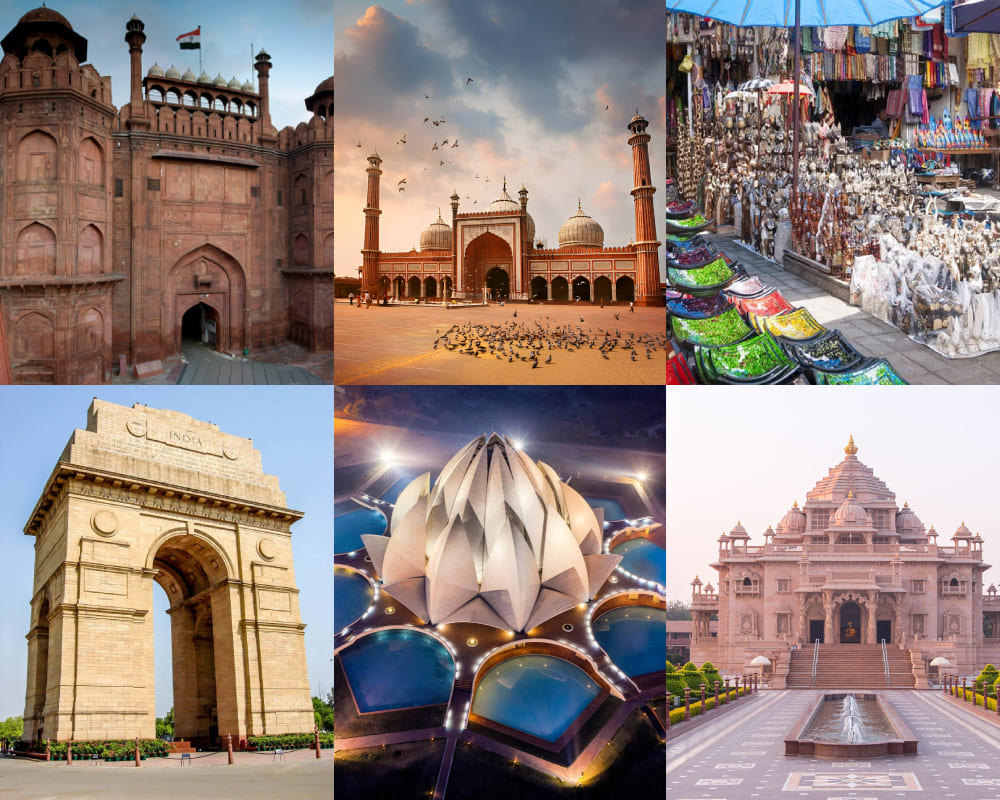
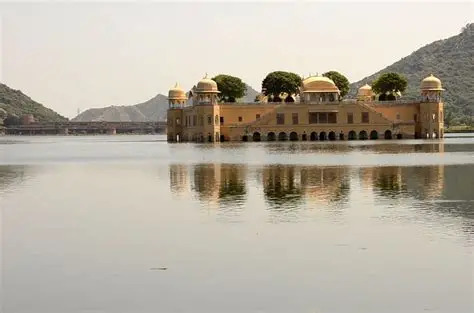
Day 2: Delhi To Jaipur
Delhi to Jaipur – A Royal Drive to the Pink City
The journey from Delhi to Jaipur is one of the most popular travel routes in North India, connecting the national capital with the majestic Pink City of Rajasthan. Spanning a distance of approximately 280 kilometers, this route offers a smooth and scenic drive via NH48, passing through historical towns like Gurugram, Neemrana, and Shahpura. Jaipur, known for its royal heritage, vibrant culture, and architectural wonders, welcomes travelers with attractions like the Amber Fort, City Palace, Hawa Mahal, and bustling local bazaars. Whether you're planning a weekend getaway, a cultural tour, or part of the Golden Triangle circuit, the Delhi to Jaipur journey is the perfect introduction to Rajasthan's regal charm and colorful traditions.
Day 3: Jaipur :- Hawa Mahal, Jantar Mantar, City palace, Water palace, Amer palace.
Jaipur, the vibrant capital of Rajasthan, is renowned for its stunning palaces and rich history. Hawa Mahal, also known as the Palace of Winds, is a remarkable five-story structure with intricately carved windows, allowing royal women to observe street festivities without being seen. The Jantar Mantar, an astronomical observatory built in the 18th century, showcases a collection of architectural astronomical instruments, emphasizing the scientific advancements of the era.The City Palace is a magnificent complex that blends Mughal and Rajput architecture, serving as the residence of the royal family. Visitors can explore its museums, gardens, and courtyards. The Water Palace, or Jal Mahal, is an enchanting palace situated amidst the Man Sagar Lake, offering breathtaking views, especially at sunset. Finally, Amer Palace, perched on a hill, is an impressive fort that exemplifies the grandeur of Rajput architecture, with its beautiful courtyards and stunning frescoes.
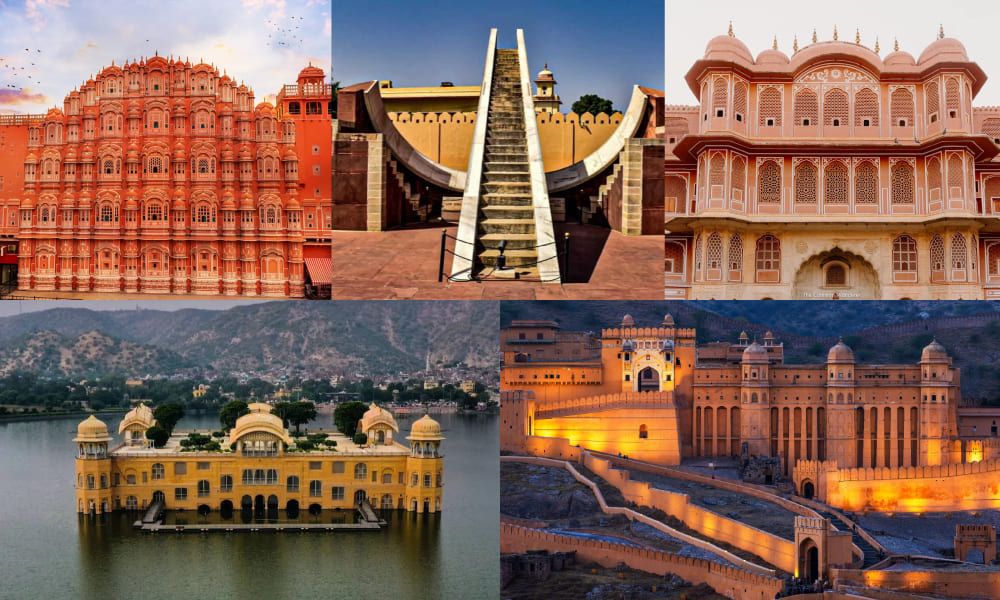
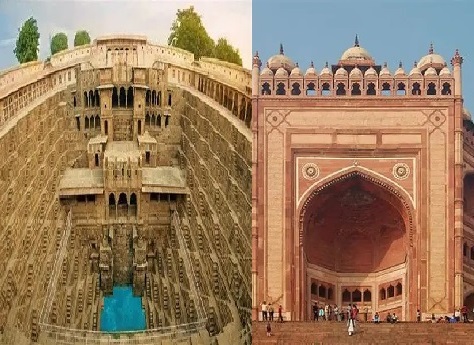
Day 4: Jaipur On The Way Chand Baori, Fatehpur Skiri Agra:- Taj Mahal, Agra Fort, Mehtab Bagh.
Jaipur to Agra via Chand Baori & Fatehpur Sikri – A Heritage Trail Through History
Traveling from Jaipur to Agra offers a memorable journey through some of India’s most iconic historical treasures. On the way, make a fascinating stop at Chand Baori in Abhaneri, one of the deepest and oldest stepwells in the world, known for its geometric beauty and architectural precision. Continuing your route, explore the grand Mughal legacy at Fatehpur Sikri, a UNESCO World Heritage Site that served as Emperor Akbar’s capital, featuring marvels like Buland Darwaza, Jama Masjid, and Panch Mahal. As you reach Agra, immerse yourself in the timeless beauty of the Taj Mahal, the world-famous symbol of love and one of the New Seven Wonders. Don’t miss the majestic Agra Fort, a red sandstone fortress that tells tales of Mughal power and splendor. Wrap up your day with a serene sunset view of the Taj from Mehtab Bagh, a riverside garden offering perfect photo moments. This route from Jaipur to Agra via Chand Baori and Fatehpur Sikri is a perfect blend of Rajput and Mughal heritage, making it a must-do cultural circuit in North India.
Taj Mahal, Agra Fort
Taj Mahal and Agra Fort – Icons of Mughal Grandeur
The city of Agra is home to two of India’s most iconic UNESCO World Heritage Sites – the Taj Mahal and the Agra Fort, both reflecting the magnificence of Mughal architecture and legacy. The Taj Mahal, often regarded as the symbol of eternal love, was built by Emperor Shah Jahan in memory of his beloved wife Mumtaz Mahal. Crafted in pure white marble, this 17th-century masterpiece is admired worldwide for its intricate carvings, symmetry, and stunning reflection in the Yamuna River, especially during sunrise and sunset. Just 2.5 km away lies the historic Agra Fort, a massive red sandstone fortress that once served as the main residence of the Mughal emperors. Within its walls are elegant palaces, audience halls, and the Musamman Burj, from where Shah Jahan is believed to have spent his final days gazing at the Taj Mahal. Together, the Taj Mahal and Agra Fort offer a captivating journey through love, power, and architectural brilliance, making them must-visit landmarks on every Agra itinerary.
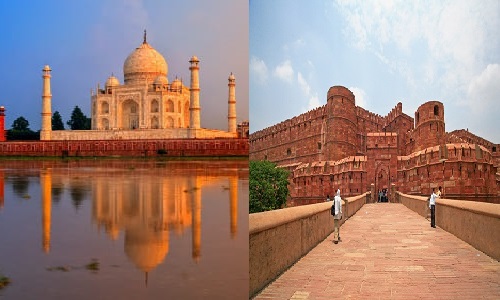
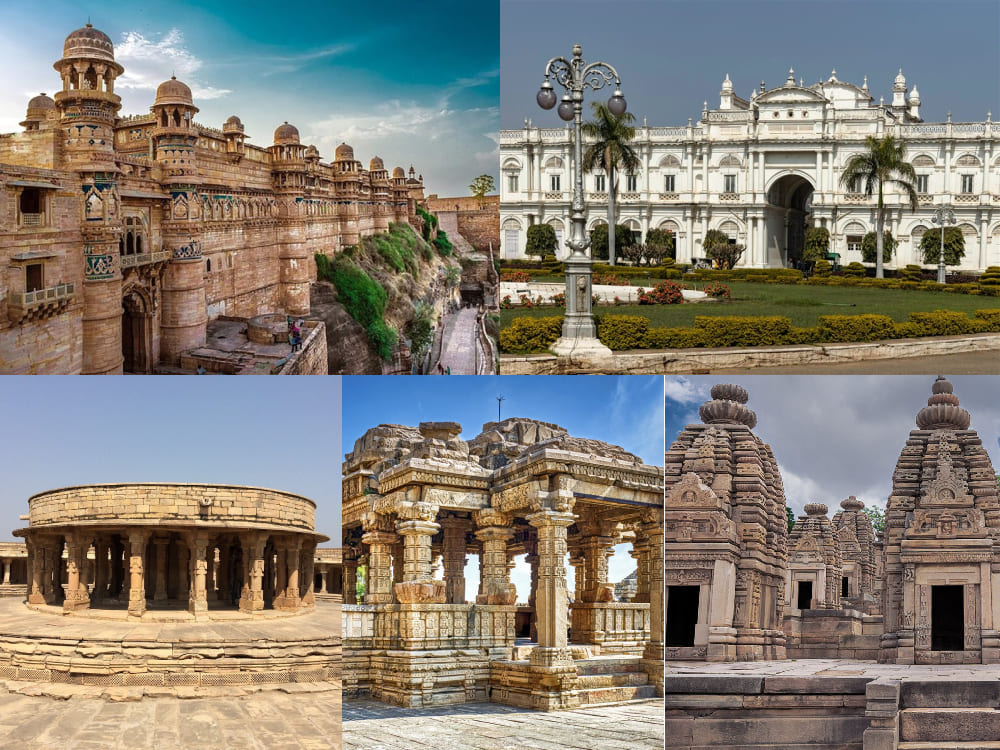
Day 5: Agra On The Way Gwalior Heritage City Tour, Gwalior Fort and Jai Vilas Palace, Mitawali, Padhavali and Bateshwar Temple. Orchha
Embark on a captivating journey through Gwalior, a city steeped in history and architectural grandeur. Start with the magnificent Gwalior Fort, perched atop a hill, showcasing stunning palaces, temples, and mesmerizing views of the city. This iconic fort is known for its impressive sandstone structures, including the Man Singh Palace and the Saas Bahu Temples, reflecting the artistry of the bygone era.Next, visit the Jai Vilas Palace, an exquisite blend of European and Indian architecture, which houses a museum showcasing royal artifacts, vintage cars, and intricate decor that narrates the story of Gwalior's royal lineage.Extend your exploration to Mitawali, Padhavali, and Bateshwar Temples, where ancient rock-cut architecture and intricate carvings tell tales of devotion and artistry. These temples, nestled in serene surroundings, offer a glimpse into the spiritual heritage and cultural richness of Gwalior, making it an unforgettable experience for history enthusiasts and travelers alike.
Orchha Sightseen :- Shri Ram Raja Mandir, Orchha Fort, Jahangir Mahal.
Orchha, a historical town in Madhya Pradesh, India, is renowned for its magnificent architecture and rich cultural heritage. At the heart of Orchha lies the Shree Ram Mandir, a beautiful temple dedicated to Lord Ram, known for its intricate carvings and vibrant murals. This sacred site is a focal point for devotees and offers a serene atmosphere for prayer and reflection.
Adjacent to the temple, the Orchha Fort stands as a testament to the grandeur of Bundela Rajput architecture. Built in the 16th century, the fort complex houses several palaces, temples, and gardens, showcasing stunning frescoes and intricate stone work.
Another gem in Orchha is the Jahangir Mahal, a palace constructed for Mughal Emperor Jahangir during his visit. This architectural marvel features elaborate carvings, stunning courtyards, and panoramic views of the surrounding landscape. Together, these sites make Orchha a captivating destination for history enthusiasts and spiritual seekers alike.
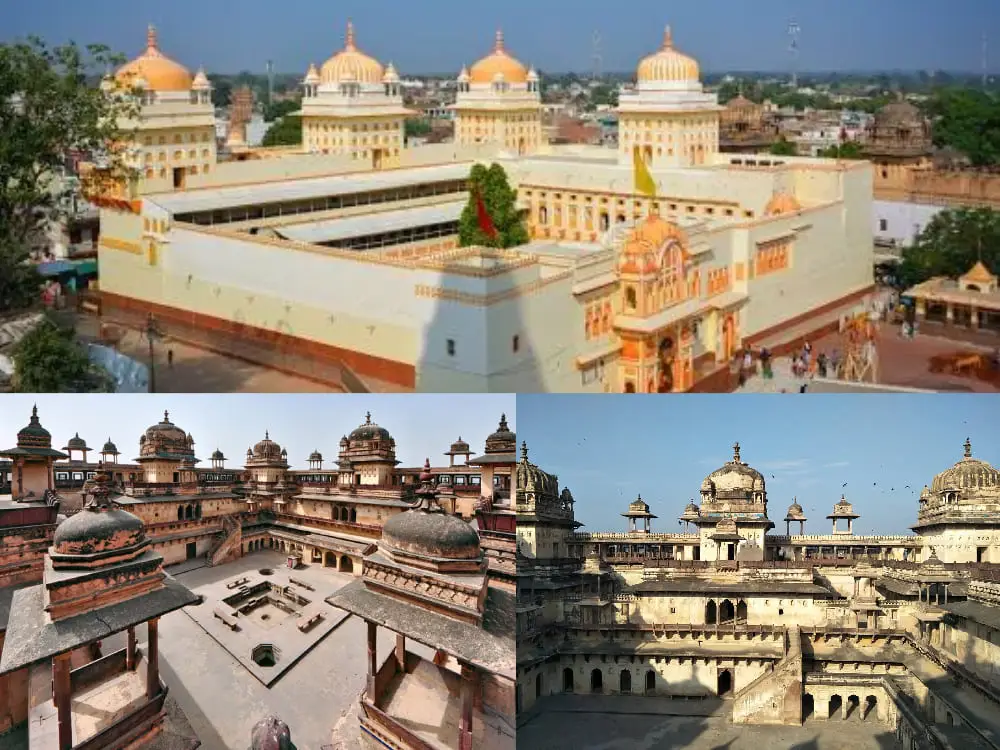
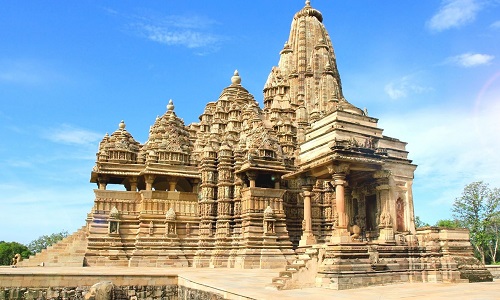
Day 6 : Orchha To Khajuraho
Orchha to Khajuraho – A Cultural Journey Through Central India
The route from Orchha to Khajuraho offers a scenic and culturally rich journey through the heart of Madhya Pradesh. Starting from the peaceful town of Orchha, known for its grand palaces, ancient temples, and the majestic Orchha Fort complex on the banks of the Betwa River, travelers are treated to a blend of Rajput architecture and medieval charm. As you continue your drive toward Khajuraho (approx. 170 km, 4–5 hours by road), the landscape transitions from historic riverbanks to rural plains. Upon arrival, Khajuraho welcomes you with its world-renowned UNESCO-listed temples, celebrated for their stunning erotic sculptures and intricate carvings that reflect India’s rich artistic and spiritual heritage. Built by the Chandela dynasty between the 10th and 12th centuries, the Khajuraho Temples are divided into Western, Eastern, and Southern groups, each showcasing architectural brilliance and cultural depth. The journey from Orchha to Khajuraho is not just a road trip, but an exploration of history, art, and spirituality.
Day 7: Khajuraho Sightseen :- Lakshmana Temple, Kandariya Mahadev Temple, Chaturbhuj Temple.
Khajuraho, a UNESCO World Heritage Site in Madhya Pradesh, India, is renowned for its stunning temples that showcase exquisite sculptures and intricate carvings, reflecting the artistic brilliance of the Chandela dynasty. Among its most notable temples is the Lakshmana Temple, dedicated to Lord Vishnu, celebrated for its beautiful exterior and a remarkable depiction of divine figures. The Kandariya Mahadev Temple, the largest and most complex temple, is dedicated to Lord Shiva and features a towering shikhara (spire) adorned with over 800 sculptures illustrating various aspects of life, mythology, and spirituality. Lastly, the Chaturbhuj Temple, known for its unique architectural design, features a central idol of Lord Vishnu and showcases a remarkable blend of artistry and devotion. Together, these temples offer a glimpse into the spiritual and cultural heritage of ancient India, drawing visitors with their breathtaking artistry and historical significance.
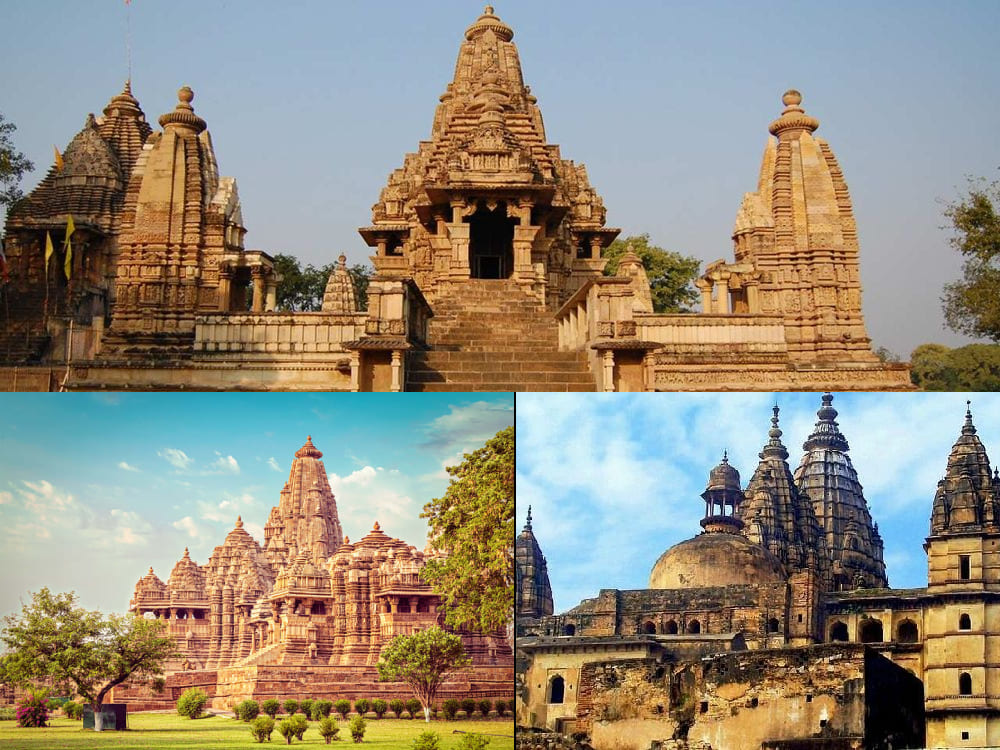
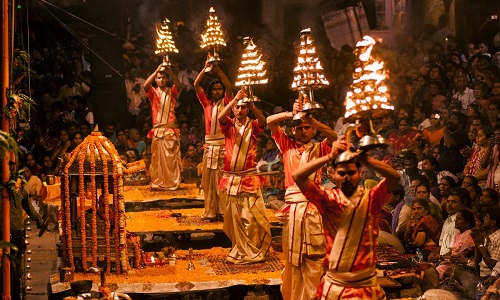
Day 8: Khajuraho To Varanasi
Khajuraho to Varanasi – A Sacred Journey from Temples to the Ghats
Traveling from Khajuraho to Varanasi takes you on a spiritually enriching journey from India’s ancient temples to its holiest riverbanks. After exploring the world-famous Khajuraho Temples, known for their stunning stone carvings and artistic brilliance, you can head east towards Varanasi, one of the oldest living cities in the world. Covering a distance of approximately 410 km (around 8–9 hours by road or 1 hour by flight), the route offers a transition from architectural marvels to divine experiences. Once in Varanasi, immerse yourself in the spiritual atmosphere of the Ganga Ghats, witness the mesmerizing Ganga Aarti at Dashashwamedh Ghat, and visit sacred temples like Kashi Vishwanath. Whether by road, rail, or air, the journey from Khajuraho to Varanasi connects two culturally and historically rich destinations, making it a must-experience route for seekers of heritage, devotion, and peace.
Day 9: Varanasi Sightseen :- Sarnath, Assi Ghat, Sankat Mochan Hanuman Temple, Ramnagar Fort.
Varanasi, one of the oldest continuously inhabited cities in the world, is a spiritual and cultural hub located along the banks of the Ganges River.
-
Sarnath: Just a short drive from Varanasi, Sarnath is a significant Buddhist pilgrimage site where Lord Buddha gave his first sermon after attaining enlightenment. The Dhamek Stupa and the Sarnath Archaeological Museum are notable attractions.Ashi Ghatt: This serene ghat along the Ganges is known for its picturesque views and tranquil atmosphere, making it a perfect spot for relaxation and meditation. Visitors can enjoy boat rides and witness the mesmerizing Ganga Aarti in the evenings.Sankat Mochan Hanuman Temple: Dedicated to Lord Hanuman, this revered temple attracts devotees seeking blessings and spiritual solace. The temple's vibrant atmosphere is enhanced by the chanting of prayers and the sound of bells.Ramnagar Fort: This historical fort, located on the opposite bank of the Ganges, showcases stunning Mughal architecture and houses a museum featuring artifacts from the royal family of Varanasi. It also serves as the annual venue for the Ramnagar Ramlila, a traditional reenactment of the Ramayana.
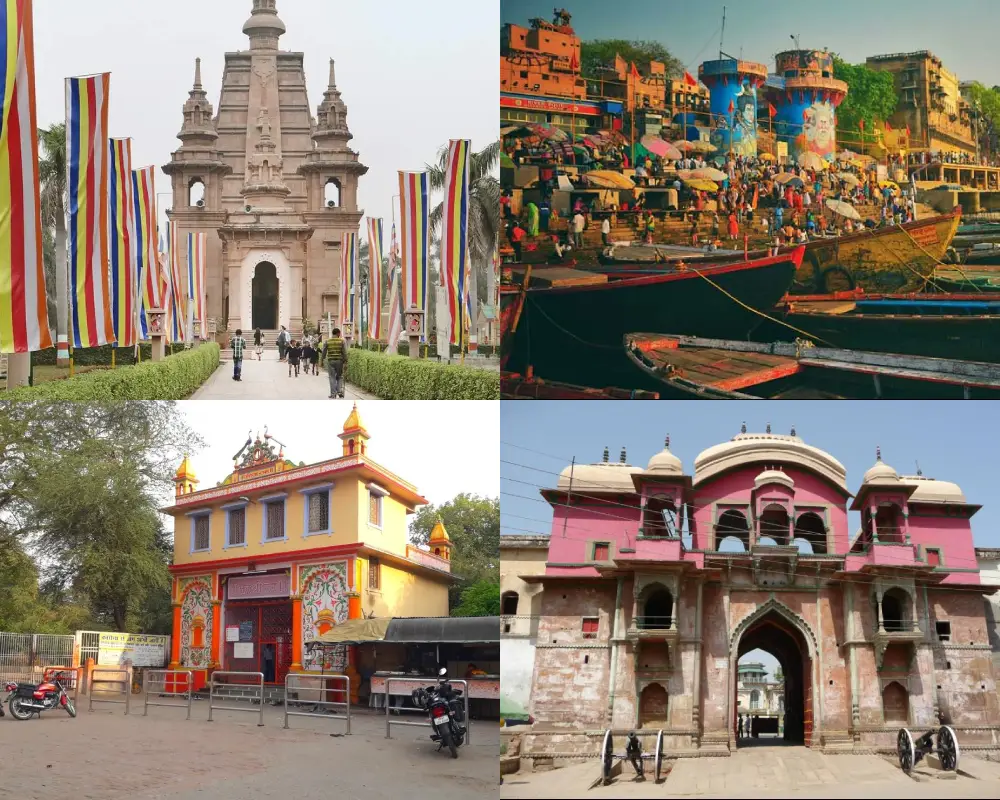
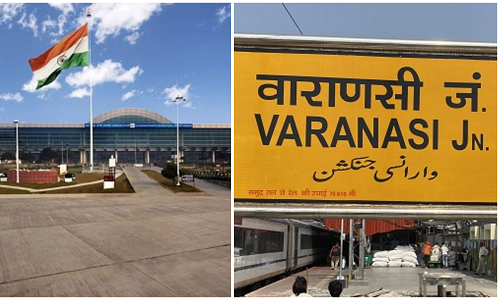
Day 10 : Varanasi AIrport/Train station
Varanasi Airport & Railway Station – Smooth Transfers in the Spiritual City
Make your arrival or departure in Varanasi stress-free with easy access to both Lal Bahadur Shastri International Airport and Varanasi Junction Railway Station. Located around 25 kilometers from the city center, Varanasi Airport (VNS) is well-connected to major Indian cities and select international destinations. Whether you're flying in for spiritual exploration or a heritage tour, our airport pickup and drop services ensure a comfortable and timely experience. For rail travelers, Varanasi Junction (BSB) is one of the busiest and most important railway stations in North India, offering direct trains to Delhi, Mumbai, Kolkata, and other key destinations. We provide reliable train station transfers with professional drivers, clean vehicles, and 24/7 service. Whether you're heading to the ghats of the Ganges, your hotel, or a pilgrimage site, our Varanasi airport and railway station transfer services are designed to make your journey seamless and convenient.

9N 10D Delhi Jaipur Orchha Khajuraho Varanasi Tour



